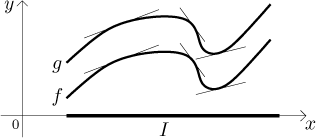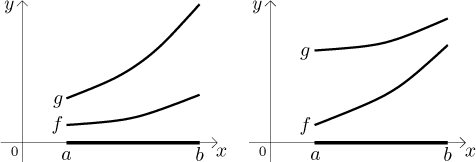
The Mean value theorem can be used to do some interesting things.
Fact.
Let f and g be functions continuous on an interval I and differentiable on its interiorInt( I ). Iff ′ = g′ onInt( I ), then there exists a constant C such thatf (x) = g(x) + C on I.If moreover there is a point c in I such that
f (c) = g(c), thenf = g on I.
We obtain this statement by considering the difference

If the two graphs also share a point and they are parallel, then they must be the same. This is used to prove that two expressions are equal in situations when we cannot do this using algebra.
Example: Prove that for
![]()
Solution:
There does not seem to be some obvious algebraic approach to this equality.
We therefore use the Fact above. We define

Thus the two functions are parallel. Now we need to substitute some point in
to show that they are equal. We try
![]()
By the fact above, the two functions are equal.
Note that sometimes it is not easy to find a suitable point to substitute. Then one can use a trick and compare limits, for instance at endpoints. Here we can compare like this:

Similarly we can prove inequalities, but there we have to be a bit more careful.
Fact.
Let f and g be functions continuous on an intervalI = [a,b) orI = [a,b] and differentiable on its interior(a,b). Iff ′ ≤ g′ on(a,b) andf (a) ≤ g(a), thenf ≤ g on I.Let f and g be functions continuous on an interval
I = (a,b] orI = [a,b] and differentiable on its interior(a,b). Iff ′ ≥ g′ on(a,b) andf (b) ≤ g(b), thenf ≤ g on I.
Here are typical situations for the two versions:

Often we use these statements with one function equal to zero, that is, to prove that, say, a given function is not negative:
Let f be a function continuous on an interval
I = [a,b) orI = [a,b] and differentiable on its interior(a,b). Iff ′ ≥ 0 on(a,b) andf (a) ≥ 0, thenf ≥ 0 on I.
All these comparison statements have "sharp" versions, we will show it for the last statement:
Let f be a function continuous on an interval
I = [a,b) orI = [a,b] and differentiable on its interior(a,b). Iff ′ ≥ 0 on(a,b) andf (a) > 0, thenf > 0 on I.
Assume that we have a nice (continuous) function on an interval I. Assume that it has two zero points in this interval. Then, logically, it must have a hill or a dip between these two zero points, and if we have differentiability, then Rolle's theorem claims that there is some point between the two zero points where the derivative is zero. If we have more zero points, we can look at all successive pairs of them and for each of them find a place with derivative equal to zero.

Fact.
Let f be a function continuous on an interval I and differentiable on its interiorInt( I ). If f has k distinct zero points in I, then its derivative f ′ must have at leastk−1 distinct zero points in I.
If the derivative is differentiable, we can do another such step. By induction we get
Corollary.
Let f be a function withn−1 continuous derivatives on an interval I and then-th derivative on its interiorInt( I ). If f has k distinct zero points in I (wherek > n), then itsn-th derivativef (n) must have at leastk-n distinct zero points in I.
This fact is sometimes used to show that some function does not have lots of zero points. We assume by contradiction that it does, then we look at its derivatives and hope for some problem.
Example: Prove that the cubic polynomial
By contradiction, assume that it has two or more roots. Take any two of them,
then by the Fact above the derivative would have to have at least one zero
point. However, this is not possible, since
A direct approach is also possible, since the above Corollary can be stated equivalently as follows.
Corollary.
Let f be a function withn−1 continuous derivatives on an interval I and then-th derivative on its interiorInt( I ). If then-th derivativef (n) has k distinct zero points in I, then f can have at mostk+n distinct zero points in I.
Note that one has to be lucky to be able to use this trick successfully. A more reliable way to count roots is to determine monotonicity of the given function, which is usually simple once we have its derivative (see Monotonicity in Theory - Graphing), and even a symbolic sketch show clearly how many roots there are.